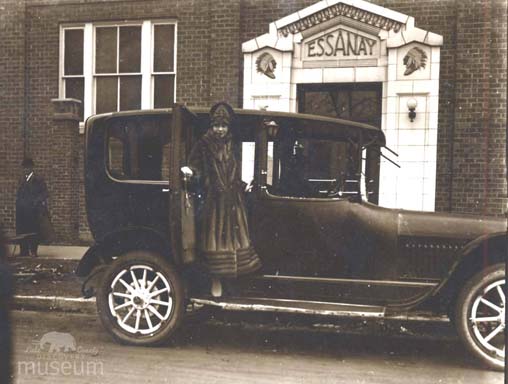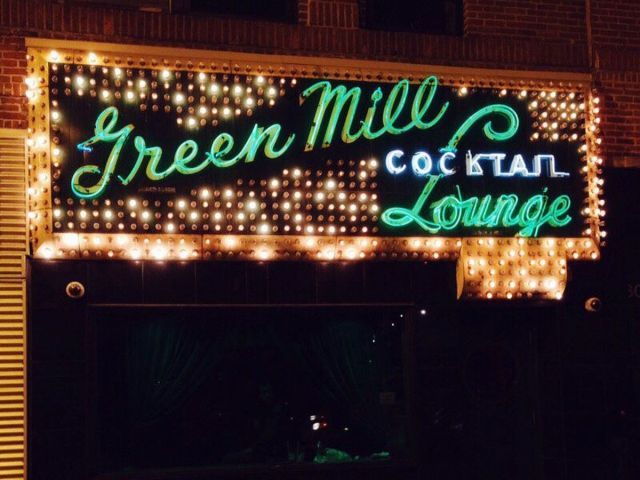
While Charlie Chaplin is well-known as a major Hollywood star and as an iconic silent film comedian, prior to that, he briefly worked in Chicago. The city of Chicago housed Essanay Studios, a landmark of the Chicago film industry, situated at 1333-1345 West Argyle Street. The movie studio derived its name from a combination of the founders’ last names: George K. Spoor and Gilbert M. Anderson. Though Essanay Studios originated in Chicago, Essanay soon expanded its operations to California, in order to take advantage of the warmer and more stable climate. Leaving Keystone Studios behind, Chaplin moved to Chicago to take on his new job with Essanay.
Fittingly, Chaplin’s first and only short silent film for Essanay Studios Chicago was His New Job (1915), which was shot in the cold of January 1915 and released on February 1, 1915. The 32-minute film tells the story of an extra (Charlie) who gets his big break when an actor on a movie set fails to show up for work. Ready to replace the actor and give his best performance yet, Chaplin’s character manages to ruin his scene, the set, and a costume with great panache.
His New Job is the first of 14 Essanay films that Chaplin made after leaving Keystone Studios when producer Mack Sennett would not honor Chaplin’s request of being paid $1000 per week. Essanay won Chaplin over with an offer of $1250 per week. As a result, the title of His New Job hints at Chaplin’s new employer. The film also pokes fun at Keystone Studios, having Chaplin’s character in the film work as an extra at the “Lockstone” Studio. Incidentally, His New Job was also the first film for which Chaplin received screen credit; his previous work for Keystone studios initially went uncredited.

Additionally, His New Job was the first Chaplin film to be photographed by Rollie Totheroh, initiating a 40-year working association with Chaplin. The film also featured a young Gloria Swanson at age 15, who can be seen in the background in an uncredited role as a stenographer. Gloria auditioned for the female lead, but Chaplin did not feel that the role suited her. Gloria later admitted that she hated slapstick comedy and had been deliberately uncooperative.

Gloria would later imitate her former Essanay co-star in Sunset Boulevard (1950) as part of her “Norma Desmond Follies” scene.
The full cast list for His New Job is as follows:
- Charles Chaplin – Film Extra
- Ben Turpin – Film Extra, in Afternoon
- Charlotte Mineau – Film Extra
- Leo White – Actor, Hussar Officer
- Robert Bolder – Studio President
- Charles J. Stine – Director
- Arthur W. Bates – Carpenter
- Jess Robbins – Cameraman
- Gloria Swanson – Extra, Stenographer (uncredited)
When Chaplin moved to Chicago to work for Essanay Studios Chicago, he lived in the Brewster Apartments at Diversey Parkway and Pine Grove. Soon, he built two homes that mirrored each other for himself and his other guests. One home was a redstone, while the other was a graystone. They stand just around the corner from Essanay at 4901 and 4900 North Glenwood.
Each day, Chaplin and many other notable players (including Wallace Beery, Broncho Billy Anderson, Ben Turpin, and Gloria Swanson) would go to work on the Essanay lot, entering through its famous terracotta entrance and onto the current film set.

Chicago also housed many local businesses and bars frequented by the Essanay stars. After shooting His New Job, Chaplin and Swanson would often drink at the Green Mill Gardens, which would later become today’s Green Mill Lounge, located on Broadway and Lawrence Avenue.

As Chaplin’s stardom continued to grow, he became more vocal about his dislike for Chicago weather and wanted to return to Hollywood to make more of a profit. Essanay tried to blackmail him to stay by threatening to send pictures of his ailing mother to the Chicago Tribune. After Chaplin resisted and left Essanay, it marked the beginning of a decline for the studio. His departure soon prompted the move of many other star players, including Swanson. With Chaplin gone, Essanay hired on French pantomime Max Linder as a last-ditch effort. His routines, however, failed to match Chaplin’s popularity in America. By 1920, Essanay had disbanded.
While Essanay Studios is no longer functioning as a film studio, its legacy is evident in the Chicago area and in its Niles, California, counterpart. Chicago History Museum honors the Essanay Chicago division with a permanent exhibit.
Unfortunately, not much of Chicago’s film history remains; however, the former Essanay Studios Chicago still stands. Once Essanay Studios Chicago stopped functioning under Spoor and Anderson, the building took on another life of its own. It was later taken over by an independent producer who made industrial films until about 1970. The studio was then passed to a non-profit television corporation, which loaned the space as the Midwest office of Technicolor productions. The Essanay location in Niles, California, no longer functions as a studio, but is instead a Silent Film Museum, housing many of Essanay’s props and equipment.
Today, the Essanay lot is home to St. Augustine’s College, which is an Episcopalian school namely serving the Hispanic community. In 2013, I was hired on as a writer for Essanay Studios Chicago, which maintained a team of wonderful people who were dedicated to the preservation of early film and Chicago’s cinematic history. At the time, St. Augustine College and our team were working to do some fundraising in order to create a center for early film in the former studio and to revitalize the space as a cultural hub for the local community. Unfortunately, the college terminated the project. Nonetheless, the history still stands, and is luckily not going anywhere.

While working there, I certainly made the most of my time there and so appreciated working in Essanay’s hallowed halls. This is the door to Essanay Studios, which is probably the most famous relic of Chicago’s cinematic contributions. It still has the original logo and the two Essanay Indians. Our fundraising efforts covered the restoration of the entrance.
In the basement of the studio, one will find the original fireproof vaults in which the film was stored. The shelving is original to the vault and has not been modified since Chaplin’s day.
The next few pictures are some shots taken around the office.
If you are curious about early film and Chicago’s role in silent cinema, I highly recommend that you arrange for a tour of the former studio. Best of all, it is free to walk past the landmark door that some of cinema’s greatest legends walked through each workday.
This post is part of the “The Charlie Chaplin Blogathon” by Little Bits of Classics and Christina Wehner. To access more information and read accompanying posts, please click on the following picture:
All images from Chaplin films made from 1918 onwards, Copyright © Roy Export S.A.S. Charles Chaplin and the Little Tramp are trademarks and/or service marks of Bubbles Inc. S.A. and/or Roy Export.



























































Wow. What a great tour through Chaplin’s Chicago days! Definitely some hallowed ground that many serious silent film fans will want to visit. Great photos, too!
Thank you! Glad you enjoyed it!
Thank you for all you do. I find this era continually fascinating and your relating of history is full of a most appealing vibrancy.